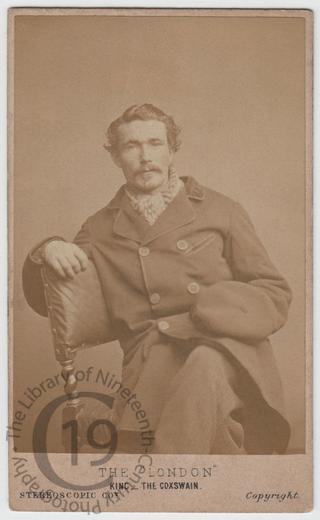
John King of the S.S. London
A carte-de-visite portrait of John King, one of the few survivors of the S.S. London, which sank on 11 January 1866 during a storm in the Bay of Biscay.
The British steamship had originally departed from Gravesend on 13 December 1865 but had been forced to take refuge in Plymouth from heavy weather in the Channel and had restarted her journey on 6 January 1866. She was bound for Melbourne in Australia with 263 passengers and crew but had been overloaded with cargo.
Only nineteen people escaped the sinking ship. Of these, only three were passengers.
‘LOSS OF THE LONDON — To the harrowing narrative of the loss of the Australian [sic] passenger steamer London we have now the good fortune of being able to add a multitude of interesting details of the most melancholy event, taken from the lips of several of the survivors during their passage by train from Falmouth to London on Wednesday. […] [T]he passengers and crew, who had beheld the starboard lifeboat washed away on the preceding day, were horrified at observing their only remaining lifeboat slip through the stern davit, break into two parts, and, of course, become utterly useless. It was then resolved that the iron pinnace, capable of carrying 50 person, should be launched, and by the aid of the donkey engine the pinnace was raised and hung over the donkey rail. When let go, however, she foundered, one man, a Dutchman, being drowned, and three others, who were rescued, being cast into the surf to leeward. Two of the men who were overboard were John King, the able seaman, to whose marvellous skill as steersman the survivors all entirely and with gratitude attribute their preservation, and Mr Munro, a passenger. […] King had one of his sides bruised and his thigh dislocated by being beaten against the steamer. […] After considerable hesitation it was agreed that a boat should be launched for the second time, and an opportunity was presented for the passengers and 16 of the crew to avail themselves of it, and if they had delayed three minutes longer than they did they would have perished in the ship. […] The crowd on board were afraid to leave the ship, having naturally been frightened by the sinking of the iron boat, and those who put off in the second boat were shouted at not to make the attempt, as their chances were hopeless. […] The captain, who was walking up and down the poop, had refused to leave his ship, but just before the boat put off he had the consideration and presence of mind to give those in the boat their “course.” He told them that it lay E.N.E. to Brest, which was correct. Before the boat could get off it was in great danger of being sucked down with the ship, which was rapidly settling in the water’ (Bedford Times and Bedfordshire Independent, 23 January 1866).
Photographed by the London Stereoscopic and Photographic Company.
A pencilled inscription verso in a period hand reads: 'King the Boatswain of the London.'
Code: 127947




